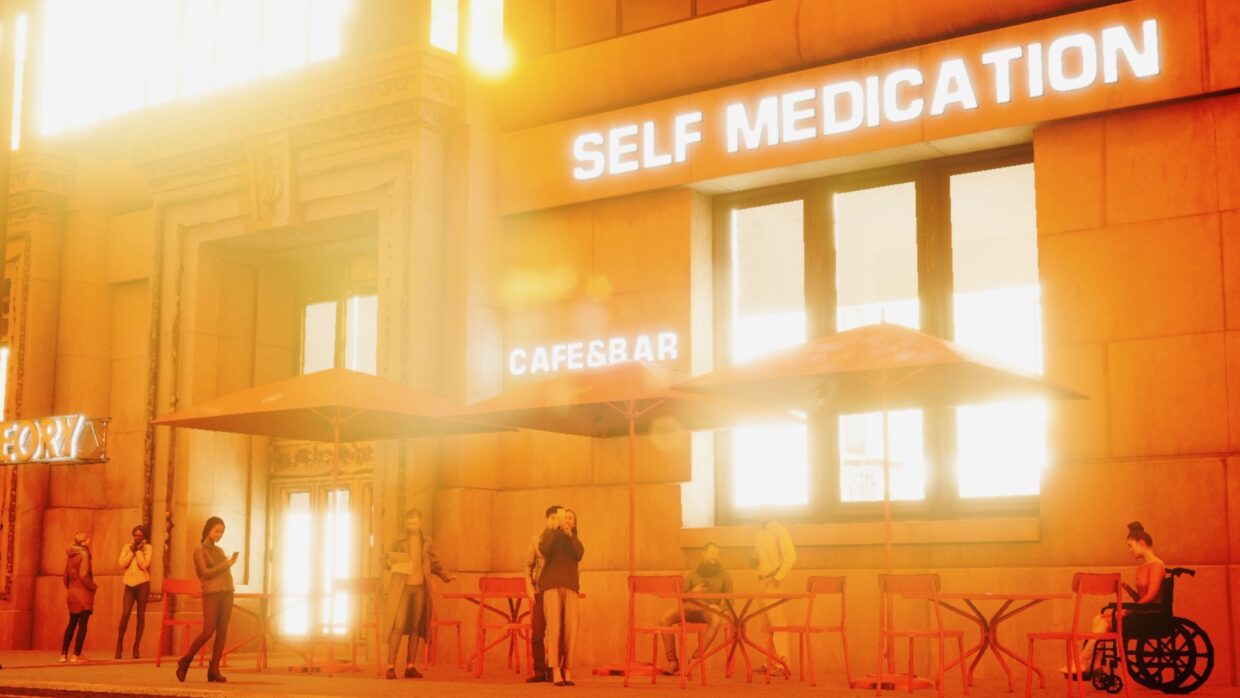 Back to selection
Back to selection
Bodiless Entities, Body Politics and Bodily Functions: CPH:DOX Inter:Active 2024
 Unbuilt Environments
Unbuilt Environments Expertly curated (under the direction of Londoner Mark Atkin, who also serves as Head of Studies of the CPH:LAB), this year’s edition of the Inter:Active exhibition at CPH:DOX (March 13-24) featured the provocative theme “Who Do You Think You Are: The Body Reexamined.” As the title might suggest, the 17 XR works were wide-ranging and eclectic, both in form (VR yes, but also mixed reality and AI chatbots) and substance (perhaps unsurprising coming from a group of creators with myriad intersectional identities).
Indeed, quite a number of the works I experienced on the top floor of the invitingly designed (palace turned contemporary arts space turned festival headquarters) Kunsthal Charlottenborg actually spoke to me — a few literally as well as figuratively. There was Czech artists Petr Salaba & Ondrej Hrach’s Anamnesis, a highly engaging game that requires the “player” to take on the role of a medical student (and me to Google “anamnesis” — “a patient’s account of a medical history”). An interactive AI simulation originally developed to train caregivers in the art of empathy through dialogue, the participant has to come up with a series of questions to type at the disembodied entity and then gently poke and prod feedback from the AI language model in order to get at the root of what’s ailing it, culminating in an empathy “score” for the “student.” (Full embarrassing disclosure: I failed miserably, having gotten into a fight with the yowling chatbot that happened to appear on my screen. On the upside, co-creator Salaba did listen empathetically when I later grumbled to him about the bitchy entity at the CPH:LAB Prototype Pop-Up event at Odd Fellow Palace.)
Luckily, I fared much better when it came to voiceover work. Kind of. The UK’s Halsey Burgund, Francesca Panetta and Shehani Fernando’s Vocalize stars an AI-assisted voice coach named Hayley, who guides the participant in the creation of a voice reel, which they can then use to “enjoy a flexible and lucrative lifestyle” as a pitch person for various ad campaigns. It’s also a dark warning for our AI-enabled future. After recording several warmup exercises and innocuous scripts, the wannabe spokesperson is rewarded with three sample advertisements featuring their voice, all of which are simultaneously hilarious and horrifying. (My personal fave was an anti-DEI commercial in which my voice lamented the fact that I’d been passed over for a job promotion in favor of an unqualified Black lesbian, at the end of which I heard this recreation of my speech declare, “White lives matter!” True to this year’s body theme, Vocalize sent chills through mine.)
Alistair Gentry is another UK artist whose work I’ll be keeping an eye out for. Unbuilt Environments is a video loop, achieved through a partnership with computer science researcher and disability activist Anna Landre, that forces the question: Whose body matters? Built in Unreal Engine and made in collaboration with disabled-led communities in East London, it’s basically a series of everyday scenes framed from the disabled POV that highlight the infuriating truth that disabled folks are not inherently disabled. Or as Gentry himself put it in his delightful Inter:Active Symposium presentation (which I caught a few days after I encountered the unique piece): “Society disables us,” as it does all marginalized people, by refusing to meet the needs of the disempowered citizenry. Utilizing “architectural fly-throughs and property developer concept images,” Unbuilt Environments makes explicit the frustration and absurdity of navigating life as a disabled person in an able-centric world, and does so firmly, and often satirically, from the insider perspective. (Right down to inside jokes like a T-rex smashing through exhibitions at an art museum. For the non-disabled, think short forelimbs not Jurassic Park.) It’s a project as bold and unapologetic as its creator, who also identifies as queer and from a “low income” background, and who concluded his “Who owns the narrative?”-themed Symposium talk with “I own the narrative, motherfucker!” To that list of identities add cockney to the core.
Though every bit as proudly radical is the Indian neurodiverse artist Poulomi Basu (another Symposium speaker), also UK-based along with her collaborator CJ Clarke, who together created Blood Speaks: Periods, Power and Protest 2013-2024. The mixed media installation “cites the body as a space of political warfare” (and was selected for the Sundance New Frontiers Lab Fellowship back in 2017, launched at SXSW 2019 and exhibited there again during this most recent edition). Indeed, the two VR works I experienced were quite viscerally compelling — if for polar opposite reasons, from enraging to empowering. The former quietly and methodically transports the viewer to Nepal to witness the strange and maddening ritual of “menstrual exile,” a practice now technically illegal (thanks in part to Basu’s relentless activism) — though the tradition of “untouchability” hasn’t exactly been stamped out, nor has its dangers. Needless to say, forcing a woman (or teenage girl in the case of Basu’s protagonist) post-childbirth to hole up in a shed until she stops bleeding, unable to touch anyone or anything save for the newborn that’s with her and the food plate she must clean herself, is downright dystopian. And a death sentence if the bleeding never actually stops on its own.
Of course the remedy to such lethal patriarchy is a good dose of feminism, which is where the latter VR experience comes in. Though the star of this piece is also a South Asian teen, she’s dealing not with the potentially fatal consequences of misogyny in Nepal but with period problems in London, specifically the stigmatization surrounding menstruation. Fortunately, we get to tag along on her unexpectedly fun journey to embracing her superhero powers, including tossing body shame aside. Along with a few tampons. Which the viewer likewise gets to grab and pitch at those set on keeping a kickass girl down.
